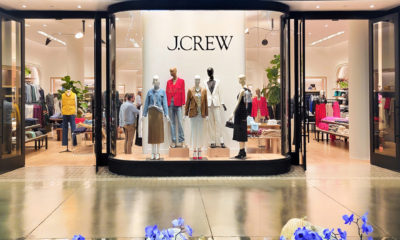Retailers have been implementing green building design for many reasons — to cut energy costs, lower their carbon footprints or align their brand aesthetic with a more environmentally friendly store environment. But a new reality soon will push the green factor even further: lighting codes.
The national energy standard has mandated that states meet ASHRAE 90.1-2007 by 2010, bringing with it more stringent lighting requirements. Among the changes in the code are more stringent interior lighting power densities; expanded exterior lighting standards; and requirements for installing occupancy sensors in specific spaces. A newer ASHRAE code, to be released in a few years, is expected to incorporate more stringency around daylighting controls and will supoport the organization’s goal to achieve net-zero energy buildings by 2015.
Another model energy code — the International Energy Conservation Code (IECC) — which covers lighting in addition to other energy-using building systems, will release a new version by the end of the year that calls for new allowances for retail display and outdoor lighting. A significant change in IECC 2009 is the fact that a design team will have to comply in entirety with either IECC of ASHRAE 90.1.
In the past, according to Craig DiLouie of the Lighting Controls Association, different sections of a design team could chose the compliance standard that worked best for them. So a project’s mechanical engineer could choose IECC, while the lighting designer could go with the ASHRAE regulation. By having to chose one standard for the entire project, says DiLouie, lighting designers will need to lobby upfront with other design sections for which code or standard will be used, which could ultimately affect design flexibility.
All these changes will force retailers to search for more energy-efficient lighting options, including LEDs and CFLs. But they’re also helping to push daylighting into the spotlight.
Let the Sunshine In
To give credit, several retailers have been bringing natural light into their spaces for years, including Walmart, Home Depot, Staples and Office Max. Kroger is testing clerestories in the current renovation of a Fred Meyer site in Portland, Ore. And REI took its skylights to a new visual level in Round Rock, Texas, with funnel-shaped shades. (Read more about that REI store by clicking here.)
A market transformation is happening whether retailers want it to or not, says Lisa Russell, a commercial designer and sustainability manager for the Association for Retail Environments (A.R.E.). “Daylighting isn’t even a ‘nice to do’ anymore,” she says, “it’s a necessity.”
Electricity accounts for almost 80 percent of the energy costs in buildings, according to the U.S. Department of Energy. And since lights generate heat, most commercial buildings require additional cooling, even in winter, to offset this heat gain, potentially adding another 20 percent to the electricity use attributable to lighting.
Daylighting, or the practice of using natural light to illuminate spaces, relies on indirect sunlight to reduce the need for electric lighting while also connecting people to the outdoors. So far, most research on daylighting has focused on its effects in schools, offices and hospitals. But a report by Heshong Mahone Group, “Skylighting and Retail Sales,” compared 108 stores in a chain retailer where two-thirds of its stores incorporated skylights. Sales at these locations averaged 40 percent higher than the non-skylight stores.
Dawn Clark, principal at NBBJ (Seattle), says buildings that allow for some natural illumination can offer a competitive advantage to building managers and retailers, since many municipalities have begun mandating green design elements. “It’s a value statement that resonates with communities and brands,” she says. Plus, she adds, “Natural light has more impact psychologically. People feel better when exposed to full-spectrum light.”
To tap into these benefits — both monetary and aesthetic — designers agree daylighting needs to be part of initial design discussions. “It’s about the power of the question and asking, ‘What are my daylighting options?’ ” says Stephen Jovicich, partner and ceo, Heights Venture Architects (Houston).
Sure, it’s cheaper to install skylights during construction rather than retrofitting. But another reason Jovicich says retailers should start the discussion during the development phase is so they can take advantage of site orientation or create space between buildings for more access to natural light. This not only aids the design process, says A.R.E.’s Russell, but can help keep projects cost neutral or at a very low premium.
Equipped to go Mainstream
Today, bringing in natural illumination so you can turn off or at least lower your artificial lighting is about more than just skylights (although it’s not a bad start). The Daylighting Collaborative, a project of the Energy Center of Wisconsin, describes daylighting as a systems approach “that combines art, science, architecture and engineering.”
Once retailers and designers have calculated desired foot candles and how best to harvest natural light, there’s the issue of what architectural elements and technology to use. Light shelves, clerestories, programmed dimming and lighting controls and windows with awnings, shades and glazing, can all play a part.
Even those trusty skylights, which began gaining attention during the 1970s energy crisis, have advanced with a plethora of options, such as diffusers that spread light evenly; improved domes that capture more low-angle sunlight; GPS units that help better track the sun’s position for optimal light harvesting; and tubes that bring light to lower levels or interior spaces.
Some designers suggest daylighting could even impact the basic tenets of store planning. For instance, perimeter walls are prime real estate for retail displays and many retailers are reluctant to give up that space for additional windows, which can add issues of glare, UV fading and product placement. But clerestory windows or light shelves that run along the top of a wall could be a viable tool for bringing in the light.
Clark also proposes transforming the traditional retail model, where stock is placed around the edges and the sales floor is located in the middle. Rather, she suggests, retailers can move back-of-house elements to the middle and open up the perimeter to more windows that not only bring in daylight but connect the interior environment with the street and people outside.
There are multiple elements to consider and designers say that a successful daylighting strategy is ultimately tailored to each space. “The technology and design solutions for daylighting are there,” says Clark. “It’s an opportunity waiting to happen.”
Useful Links:
U.S. Department of Energy
www.energycodes.gov
Daylighting Collaborative, a project of the Energy Center of Wisconsin
www.daylighting.org
The Rocky Mountain Institute
www.rmi.org
ASHRAE
www.ashrae.org
Whole Building Design Guide
www.wbdg.org
Daylighting 101
An overview of some design considerations associated with daylighting:
Solar Heat Gain Coefficient (SHGC)
A measure of how much heat makes it through a glass window or skylight compared to the amount that strikes it, expressed in a number between 0 and 1. The lower a window’s SHGC, the less solar heat it transmits.
UV Fading
Ultraviolet light (UV) is the invisible portion of
the light spectrum. The damaging effects on long-term UV exposure include fabric fading and plastic deterioration.
Glare
Too much light can mean excessive brightness. A properly daylit building uses carefully placed windows, shading devices and low-transmittance glass to block direct sunlight and reduce glare.
Cloudy days
According to the Daylighting Collaborative, even a completely overcast sky provides 5000 to 6000 foot candles of illumination. In fact, overcast skies typical in northern climates can serve as a better lighting source because the light is more diffuse and even. In the sunny south, daylighting is more challenging and must be carefully controlled.
Reflection
To control the distribution of daylight within a space, designers also must consider interior surface reflectivity. Light-colored walls, ceilings and furnishings can help deliver a smooth and even distribution of light without causing visual discomfort.

 Photo Gallery2 weeks ago
Photo Gallery2 weeks ago
 Headlines5 days ago
Headlines5 days ago
 Headlines1 week ago
Headlines1 week ago
 Headlines2 weeks ago
Headlines2 weeks ago
 Headlines2 weeks ago
Headlines2 weeks ago
 Headlines4 days ago
Headlines4 days ago
 Headlines3 days ago
Headlines3 days ago
 Designer Dozen1 week ago
Designer Dozen1 week ago












